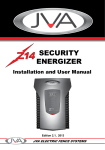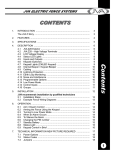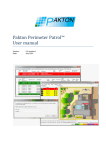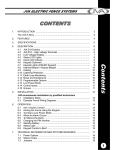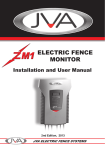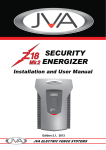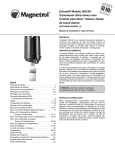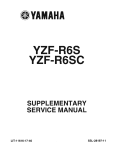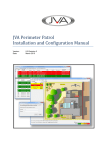Download SECURITY ENERGIZER
Transcript
SECURITY
28
ENERGIZER
Installation and User Manual
9.2 9.0
o
p
Edition 2.1, 2013
JVA ELECTRIC FENCE SYSTEMS
JVA Z Energizer Range Concept
JVA ELECTRIC FENCE SYSTEMS
Thank you for choosing our product. The JVA brand is a range of electric fencing
products carefully selected from leading manufacturers around the world to
meet the needs of perimeter security.
THE JVA Z RANGE ENERGIZER CONCEPT
The JVA Range of Energizers has been collaboratively designed and manufactured
by an international team with over 30 years of electric fence experience earned
in some of the most testing security environments in the world. It aims to provide
the very best low-cost, high-voltage security energizers in the world. They are
compact, integrated and fully programmable electric fence energizers with built-in
alarm units and LCD out and return voltage display. They also have the option of
being controlled from a remote LCD keypad.
State-of-theart energizer
design IP4 x
and ABS plastic
Unique LCD
display depicting
fence out and
return voltage
Unique LCD keypad
option depicting fence
and alarm condition
2-yr
NTY
A
WARR
Wall-mountable, robust
energizer housing with easily
detachable PCB chassis for
ease of installation and repair
TWO-YEAR WARRANTY
All JVA products carry a 2-year warranty against defective
components and workmanship. The warranty excludes damage
!"#!$$#%$#&'
supply surges, rough handling, malicious action or incorrect wiring.
Please retain your invoice as proof of purchase and
JVA ELECTRIC FENCE SYSTEMS
CONTENTS
INTRODUCTION ......................................................................................
The JVA Z Story ........................................................................................
3
3
2.
FEATURES ...............................................................................................
4
3.
SPECIFICATIONS ....................................................................................
5
4.
DESCRIPTION .........................................................................................
4.1 JVA Z28 Exterior ..............................................................................
4.2 JVA Z28 – High Voltage Terminals ..................................................
4.3 LCD Voltage Display ........................................................................
4.4 Status LED Lights ............................................................................
4.5 Inputs and Outputs ..........................................................................
4.6 Keypad (Optional) ............................................................................
4.7 Keypad Lights (236LED Keypad) ....................................................
4.8 Internal Beeper / Keypad Beeper ....................................................
4.9 Cabling ............................................................................................
4.10 Lightning Protection .........................................................................
4.11 Earth Loop Monitoring .....................................................................
4.12 Noise and Interference ....................................................................
4.13 Programmable Options ....................................................................
4.14 Low Power Mode .............................................................................
4.15 Control Inputs ..................................................................................
4.15.1 Control Inputs ......................................................................
4.15.2 Control Input Functions .......................................................
4.16 Simultaneous Pulse Feature ...........................................................
6
6
6
7
8
8
9
9
9
10
10
10
10
10
10
11
11
11
11
5.
INSTALLATION .........................................................................................
5.1 Installation Steps .............................................................................
5.2 Example Fence Wiring Diagrams ....................................................
12
6.
OPERATION .............................................................................................
6.1 Arm / Disarm Control .......................................................................
6.2 Arming the Fence Using the Keypad ...............................................
6.3 Turning to Low Power Mode ............................................................
6.4 When an Alarm Occurs ....................................................................
6.5 To Silence the Alarm ........................................................................
6.6 Changing the PIN number ...............................................................
6.7 Standby Battery ...............................................................................
6.8 Status Light ......................................................................................
15
15
15
15
15
16
16
16
16
7.
LCD KEYPAD OPERATION .....................................................................
7.1 Arming/Disarming the Fence Using the Keypad ..............................
7.2 Keypad Status Display ....................................................................
7.3 Changing the Keypad Messages and Address ................................
17
17
17
17
Contents
1.
12
13
1
JVA ELECTRIC FENCE SYSTEMS
8.
Contents
9.
10.
11.
2
12.
TECHNICAL INFORMATION ....................................................................
8.1 Power Options .................................................................................
8.2 Status Codes ...................................................................................
8.3 Jumpers ...........................................................................................
8.3 Multiple Keypads .............................................................................
INSTALLATION PROGRAMMING OPTIONS ..........................................
9.1 Programming Mode .........................................................................
9.2 To Exit Programming Mode .............................................................
9.3 Changing the Installer PIN ...............................................................
9.4 Changing an Option .........................................................................
9.5 Programming Options in Brief .........................................................
9.6 Programming Options in Detail ........................................................
9.6.1 Power Level (01x#) ..............................................................
9.6.2 Low Power Level (02x#) ......................................................
9.6.3 Fence Alarm Voltage (03x#) ................................................
9.6.4 Fence Alarm Voltage Zone 2 (04x#) ....................................
9.6.5 Low Power Alarm Level (05x#) ............................................
9.6.6 Missed Pulse Count (06x#) .................................................
9.6.7 Battery Alarm Voltage (07x#) ...............................................
9.6.8 Siren On Time (08x#) ..........................................................
9.6.9 Siren Off Time (09x#) ..........................................................
9.6.10 Siren Cycles (10x#) .............................................................
9.6.11 Input Type (11x#) .................................................................
9.6.12 Input 2 and 3 Functions (12x#) ............................................
9.6.13 Gate Entry/Exit Delay (13x#) ...............................................
9.6.14 Chime Mode (14x#) .............................................................
9.6.15 Binary Options (16x#) ..........................................................
9.6.16 Anti-bridging threshold (17x#) .............................................
9.6.17 Binary Options 2 (18x#) .......................................................
9.6.18 Fence Entry/Exit Delay (19x#) .............................................
9.6.19 Auto Re-arm Time (20x#) ....................................................
9.6.20 Relay Functions ...................................................................
9.6.21 Relay Function Details .........................................................
9.6.22 Group Mode (26x#) ..............................................................
SECTOR SETUP TESTS AND ADJUSTMENT ........................................
10.1 Basic Fence Tests ...........................................................................
10.2 Fault Condition Tests .......................................................................
21
22
22
22
23
24
24
24
24
24
25
26
26
26
26
27
27
27
27
28
28
28
29
29
29
30
30
31
31
32
32
33
34
34
38
38
38
SOME STANDARD REQUIREMENTS FOR ELECTRIC
SECURITY FENCES ................................................................................
........................................................................................
11.2 Installation, Operation and Maintenance .........................................
11.3 Warning signs ..................................................................................
11.4 Gates ...............................................................................................
11.5 Earthing ...........................................................................................
11.6 Protection ........................................................................................
WARRANTY .............................................................................................
39
39
39
40
40
40
41
43
JVA ELECTRIC FENCE SYSTEMS
1. INTRODUCTION
Welcome to the world of JVA monitored electric security fences. The proliferation of
non-lethal, monitored, electric security fences in our towns and cities is indicative of
popularity is simple – monitored electric security fences are effective, economical,
simple to install, and they offer more D’s of security than any other perimeter
system:
Every second, the JVA Z energizer
discharges a very short-duration,
safe, high-voltage pulse down
the fence live wire. The JVA Z
energizer then monitors the voltage
at the end of this live wire, thereby
checking that the voltage is being
maintained along the entire fence
line. In the event of a voltage drop
caused by either shorting, cutting
or poor maintenance, the monitor
will trigger an alarm, thus alerting
you.
Introduction
DEMARCATION – The JVA fence around your property shows you mean business.
DEFLECTION
DETERRENCE – The safe, powerful JVA shock is a strong deterrent to intruders.
DELAY – The physical barrier will delay an intruder, something they do not like.
DETECTION – The JVA’s voltage monitor warns you of any tampering with the fence.
DENY – A well-erected electric security fence will deny entry.
DEPENDABLE – 60 seconds a minute, 60 minutes an hour, 24 hours a day, 365 days
a year, your JVA electric security fence is monitored by an alert, sober, electronic
watchman.
Manufactured to meet the most
stringent
international
safety
standards, the JVA Z energizer is
in a class of its own when it comes
affordable price.
An electric fence system which
meets current safety regulations
3
JVA ELECTRIC FENCE SYSTEMS
2. FEATURES
2.1 Power
! 8 joules peak output energy (4 + 4 Joules = 8 Joules total)
! Mains powered via external transformer (16–18Vac)
! Battery charger with space for internal 7A/H 12V rechargeable back up battery
2.2 Control / Monitoring:
! "$
%&'&$
! 3 12V driven outputs (also referred to as relays), high side switched (common
Features
negative)
! All relays may be assigned to any alarm function
! LCD voltage display
! LED status lights
! Internal beeper
! AC fail, Low Battery and Bad Battery detection
! Keypad programmable options
! Low power mode – ensures detection together with public safety during the day
! Adjustable energizer power output level
2.3 Safety
! Designed to pass IEC60335.2.76 and EMC standards (reports available on
request)
! Enclosed fence terminals
! Wall mountable, robust enclosure with detachable PCB chassis for ease of
installation and repair
2.4 Reliability
! Microprocessor controlled.
! Pluggable screw terminals
! State of the art, robust, case design IP4x ABS
! Built-in lightning protection from both mains and fence sides, external fence
lightning protection is still advised in high lightning prone areas
! All inputs and outputs protected against stray fence voltage
4
JVA ELECTRIC FENCE SYSTEMS
3. SPECIFICATIONS
Energizer Output Voltage
8.5kV peak no load
Peak Output Energy
2 × 4 Joules
Pulse Rate
Locked at 0.9 Hz
12v DC Power Consumption
Energizer On – 1005mA average, 1220mA peak
Energizer Off – 28mA
Not including keypad or Auxiliary power
AC Power Input
16-18Vac 1.5A*
Battery Charger Output
Float voltage 14V, 700mA, short circuit
protection, reverse battery protection
Switched Outputs
Three 12V 2.5A maximum combined load
powered output.
Recommended Operating
Temperature
–15°C to +50°C
Enclosure
IP4x ABS Plastic
Size
300mm high, 190mm wide, 115mm deep
Weight – packed, no battery
2.5kg
* A 24Vdc 1.5A supply can be used in place of the 16Vac. The correct connection is +24V to the right AC pin, GND to the left AC pin. Due to the stored
energy in a 24Vdc plug-pack, an AC Fail could occur 5 minutes before the Energiser reports this fault
; <
; <
>
Series energizers.
; <
>?@
take a long time to discharge. Wait at least 10 minutes
after turning off before opening the case.
WARNING
; X%
<
[
mended that the energiser be disarmed and an intentional short circuit
is placed from the fence live wires to earth. This is a sensible precaution
against the energiser being turned on by others or malfunctioning while
working on the fence.
; \
between two separate electric fences, each powered by separate energis[
]^
[
group mode.
5
JVA ELECTRIC FENCE SYSTEMS
4. DESCRIPTION
The Z28 is a dual channel standard (non Bi-Polar) 8 Joule (4 per channel) security
energizer.
This manual relates to:
Description
! _$X<`{^
! |<`{^}
~
<
the LCD on reset)
9.2 9.0
o
p
4.1 JVA Z28 Exterior
Figure 1: Z28
!
ZONE 2 RETURN
6
EARTH RETURN
ZONE 1 RETURN
ZONE 2 OUT
EARTH
ZONE 1 OUT
Figure 2: Output Terminals
JVA ELECTRIC FENCE SYSTEMS
4.3 LCD Voltage Display
The display on the JVA Z28 shows the voltage at the feed out and return terminals.
Left side = Return zone 1, Right side = Return zone 2.
The LCD also shows the programming option and current setting when in
programming mode. This allows the programming options settings to be checked
easily.
–
RETURN HV
–
ZONE 2
Description
ZONE 1
Figure 3: LCD Display and Status LEDs
7
JVA ELECTRIC FENCE SYSTEMS
"#
!
On>
~[
in low power mode.
"!
Flashes if the return voltage falls below the Fence Alarm Voltage,
stays on when there is a Zone 1 fence alarm.
#!
Flashes Red when the Gate is open, stays Red when there is a
Gate 1 alarm.
Description
$
%
On whenever the energizer has power.
On>]~[
mode.
"
Flashes if the return voltage falls below the Fence Alarm Voltage,
stays on when there is a Zone 2 fence alarm.
#
Flashes Red when the Gate is open, stays Red when there is a
Gate 2 alarm.
&
Flashes an error code for energizer (service) errors. See the table
in section 7.2 Status LED Error Codes.
'(): Fence and Gate LEDs are latched on (like the strobe) until cleared using the
clear alarm memory sequence (*1#) or the Energiser is re-armed.
4.5 Inputs and Outputs
16VAC
Output Feed
terminals
Output Return
terminals
Keypad
Control
Inputs
Control
Outputs
16VAC
Only!
Figure 4: Connection Terminals
8
JVA ELECTRIC FENCE SYSTEMS
4.6 Keypad (Optional)
Up to three keypads can be used to remotely monitor and control the Z28. A keypad
is required to set the programmable options. See section 8.5. The keypad will display
the fence voltages, alarms and statuses.
*+
$%&#
%
On with AC power, Off
[
On
~[
mode.
Description
Figure 5: LCD Keypad
'(): There is no panic function currently implemented.
For information on how to control the Z28 via the keypad see section 6.
4.8 Internal Beeper/Keypad Beeper
Depending on the chime mode setting, the internal beeper and keypad beeper will
sound when there is a fence alarm, a gate alarm or a general alarm or a door
' %
automatically enters low voltage mode to preserve the battery. On AC Fail it will not
beep.
9
JVA ELECTRIC FENCE SYSTEMS
4.9 Cabling
High voltage cabling (fence lead out and returns) should be run using suitably rated
cable. Double insulated electric fence underground cable is suitable. High Voltage
Cables must ,be run within the same conduit as Low Voltage Cables. A minimum
distance of 30mm should be kept between High Voltage and Low Voltage cables.
'*#+
Description
Although the Z28 contains internal lightning protection elements, external lightning
protection elements such as additional external lightning kits available from your
local dealer, are recommended as they would help to reduce lightning damage even
further.
'',#&-
The Z28 has two fence earth terminals which when wired into a series looped fence
\
[
one earth spike location must be used. If this is not required the installer can loop the
two earth terminals at the energizer and then connect the earth spikes to one of the
parallel earth terminals.
4.12 Noise and Interference
The Z28 contains a microprocessor. Extreme electrical noise can upset
microprocessors. The most likely cause of such noise is the high voltage output from
the unit itself. In the event of erratic behaviour, check that the high voltage wiring is
%>]
to self-recover from interference, powering off (both AC and battery) should not be
necessary.
4.13 Programmable Options
The Z28 has many programmable options. These are also known as setup
parameters. To alter these options a keypad must be used. The options are explained
in Programming Options in Brief on page 20. Each parameter has a factory set
default.
4.14 Low Power Mode
Z28 energizers can be switched into low power mode. Low Power mode may be used
in situations where the fence is not required to be a deterrent but is still required to
actively detect intrusion. In Low Power mode the fence live wires operate at a much
lower voltage, typically 500V peak. See Programming Options in Brief on page 20 for
details on using the keypad to set low voltage mode.
10
JVA ELECTRIC FENCE SYSTEMS
4.15 Control Inputs
!.!*/&
The Z28 has 3 control inputs. These default to:
Input 1 – Arm/Disarm
Input 2 – Gate 1
Input 3 – Gate 2 or low voltage mode input.
The gate inputs may be wired to a gate switch to trigger an alarm when a gate is
opened.
If the unit is disarmed, the gate input may be set to chime mode. See Programming
Options in Brief on page 21.
\
]"
?Programming Options in
Detail, Option 12.
!.*/&"&
':';:+<
''\
[
$
\
|
Zone. On/Arm will make the Fence Live (High Voltage on the Fence), while Off/
Disarm will make the fence Safe (No fence voltage)
#/&
\
[
$
\
trigger an alarm when the gate is opened for longer than the Gate Entry/Exit Delay
time (Option 13). The timer will reset to zero when the gate closes. If the energizer
is disarmed, the Gate Input may be set to Chime Mode. See section 9, option 14.
Description
'(): If not used, the Gate 1 and Gate 2 inputs must be bridged to the Com terminal.
=:
%
*
_ [ $
\
change the Energizer Output (While Armed) to either High Power or Low Power
modes. It is also used to determine what Power Mode to start in when the energizer
is Armed using a Control Input.
4.16 Group Simultaneous Pulse Feature
All JVA Z Range models may be linked to form a group to power multiple zones. See
Group Mode, page ??.
11
JVA ELECTRIC FENCE SYSTEMS
5. INSTALLATION
>?@B&
Installation
5.1 Installation Steps
1.
2.
Design and build the fence. (Beyond the scope of this manual.)
3.
Decide where the JVA Z28 is to be mounted. If on an external wall it should
sunlight.
4.
Mount the unit by hanging the housing on the two nail-in anchors provided.
If necessary, two extra mounting holes can be used at the bottom of the
housing.
5.
\%[<
%
wall.
6.
Wire the low voltage cables to the PCB terminals (right side)*. (See page 8)
7.
Wire the high voltage cable to the PCB terminals*. (See page 8) If earth
monitoring is not going to be used on the fence, connect a bridge wire from
earth out to earth return.
8.
Fit the battery leads to the battery. The Status LED should blink twice to
show mains fail.
9.
Mount the 220 – 16V transformer and connect the 16V side to the Z28 16V
input terminals. (AC is not polarity sensitive.) Do not connect a live or neutral
to the earth terminal.
10.
<
state of the inputs.
11.
Replace the front cover.
12.
Turn AC power on.
13.
< %
%[ Status LED should stop blinking.
14.
If using a keypad, type *68#. The keypad will analyse the zones.
15.
Arm the unit. The LCD display will now show the fence voltage.
16.
Check to ensure that a short anywhere on the fence triggers the alarm.
17.
On handing the system over to the owner/user, explain how to change the
user PIN. Leave a User Manual with the user.
*D %&070'**
&
12
;70
JVA ELECTRIC FENCE SYSTEMS
5.2 Example Fence Wiring Diagrams
Feed
Return
Installation
Return 2
Earth
Return 1
Feed 2
Earth
Feed 1
Fence 1
Fence 2
Earth spikes
JVA Z28 Energizer Fence Wiring, Including Earth Monitoring
13
JVA ELECTRIC FENCE SYSTEMS
Feed
Return
Installation
Return 2
Earth
Return 1
Feed 2
Earth
Feed 1
Fence 1
Fence 2
Earth spikes
JVA Z28 Energizer Fence Wiring, without Earth Monitoring
14
JVA ELECTRIC FENCE SYSTEMS
6. OPERATION
6.1 Arm/Disarm Control
The unit can be controlled by the keyswitch, control input 1 or via a keypad. The
keypad also allows instant audiovisual indication of the state of the energizer and
therefore the fence it is powering.
If there are two ways to control the energizer both connected at once, i.e. keypad and
control inputs, then the last change will determine the result. So if the unit is armed
via the keypad and then disarmed at the control input it will disarm.
<
=>%&
! Enter your E)$%/ number (four digits long; default is 1 2 3 4) and push the #
! Make sure the red ARM light comes on.
! %
! The fence will power up and if all is well (no faults) the system will be ready to
deter and detect.
! If there is a fault on the fence and it cannot achieve full voltage, zone 1 or zone 2
@
! To disarm the system, enter your E)$%/ and press #. This will also clear any
fault lights and zone lights which may have been on.
<?!#7+7
Operation
key.
To switch to Low Power mode, enter your E)$%/ and press *41#. In Low Power
mode the fence will still be powered and any breach will be detected, but the voltage
_
mode.
Enter your E)$%/ and press *42# to switch back to Full Power mode.
Alternatively, the unit can be switched to Low Power mode using control input 2, if it
has been programmed accordingly.
<@
H
If the system is armed and the fence is tampered with, the corresponding Zone Light
on. If the energizer is connected to a building alarm system for monitoring, an alarm
signal may be sent to the alarm company monitoring the alarm system.
15
JVA ELECTRIC FENCE SYSTEMS
An alarm will also sound if input 2 is assigned to the “gate input” function and the
gate input is opened and the entry/exit delay time has elapsed.
After the siren has cycled on and off according to the times and numbers set in
options, the siren will stop sounding. The on and off timing is able to be set in the
options. The Strobe will remain on. After a further delay (Auto Rearm Time) the
siren will again respond to the next alarm condition with a new set of on / off cycles.
If the alarm condition (low fence voltage or gate input) is removed, the siren will stop
after the end of the current “on” time (Siren On Time).
Operation
If the siren is muted by (entering %/G) then the siren will enter the next “off” cycle
(Siren Off Time). If the alarm condition is still present (voltage is low) the siren will
sound again after the preset “off” time. If the alarm condition is not present the
energizer is instantly rearmed, irrespective of the auto-rearm setting.
<Q!"
! Enter your E)$%/and press #. This will silence the alarm but not disarm the
system; the Armed Light will still be on. If Auto-Rearm is set, the system will be
ready for the next alarm. Note that the following functions have an effect on alarm
timing: Siren On time, Siren Off time, Siren Cycles, Auto Re-arm time).
!
%
! The siren and strobe are ready to respond again if triggered.
! To disarm the system, enter your E)$%/ and press # again. The zone light
will remain lit until the Clear Alarm Memory command (*1#) is entered.
! Alternatively, disarming using the key switch will reset the alarm.
<<T>",U+XYY
! Enter the old 4-digit E)$%/and press *0#. This enters User Programming
!
!
!
!
mode.
Enter your new E)$%/(must be 4 digits) and then #.
Press *# to exit User Programming mode.
Make sure your new E)$%/works by using it to arm the energizer.
The default PIN is 1 2 3 4.
6.7 Standby Battery
Should there be a loss of mains power, the Power Light on the keypad will go off.
If the loss of power is prolonged, the battery may discharge power and become
ineffective. The Power Light
If the standby battery requires replacement, the Status Light
<"#
If the energizer develops an internal fault, the Status Light?
section 7.2 (page 19).
16
JVA ELECTRIC FENCE SYSTEMS
7. LCD KEYPAD OPERATION
$' \;
=>%&
The fence will power up and if all is well (no faults) the system will be ready to deter
and detect.
To disarm the system enter your USER PIN and press #.
'(): If there is an alarm sounding you will need to enter your PIN twice, once to
silence the alarm and once more to disarm.
7.2 Keypad Status Display
In normal operation the keypad shows a continuous summary of the system status.
For example if the system is disarmed the keypad will display “Ready to Arm”.
If the system is armed then the keypad will display the voltages for each zone in
the system.
Since there can be many things to display the keypad automatically “scrolls” through
all relevant detail. Each screen is show for about 2 seconds. If you wish to hold the
display at a particular point simple press the [#] key. The auto scrolling will stop for
about 20 seconds.
Pressing the [#] key again will advance the display one step.
If a new trouble (AC fail, low battery etc) or alarm occurs, the keypad screen will
jump to the relevant zone, the keypad will beep (unless toggled off) and auto
scrolling will cease for about 3 minutes.
$? T%&-
LCD Keypad Operation
Enter your USER_\&~_\
&`
the # key. Make sure the red ARM light comes on and the keypad beeps twice to
The messages and each of the 15 zone labels can be changed.
The Dealer Message displays when the system is on standby.
Zone Labels display after the [#] key is pressed during alarm memory or faults.
The programmable Service Message is displayed during AC failure, communication
failure, or low battery.
17
JVA ELECTRIC FENCE SYSTEMS
LCD Keypad Operation
H!I&J
[1]
[2] Character up
[3] not used
Emergency not used
[4] <- Cursor left
[5] Next Message
[6] -> Cursor right Fire not used
[7]
[8] Character down
[9]
Panic not used
[*]
[0] Last Message
[#] Enter / Exit
Bypass not used
To activate the keypad programming mode, enter the [Installer’s Code] [*][0][1][#].
Information may be entered into the keypad in the form of letters (upper and lower
case), numbers (0 - 9), and 22 special symbols. All characters are displayed in the
order: upper and lower case letters, numbers, and special symbols. The [Space]
character precedes the letter A.
To enter a Label, use the [2] key to scroll through the characters until you reach the
desired character. If you scroll past the desired character, the [8] key may be used
to scroll backwards. NOTE: the space character is before the A character (When A
is displayed, press [8] to get a space).
When the desired character is displayed, press the [6] key to move the cursor to the
next character position. The [4] key moves the cursor to the left.
When all characters have been entered, press the [#] key to enter the message and
move to the next message position.
Use the [0] key to move backward through the messages.
'(): If you move to the next message using [5] instead of the [#] key you will lose
any changes you made!
To change the keypad address, scroll through the messages until the keypad
displays: “Keypad address __” then change the value by pressing [2] (up) or [8]
(down). Validate by pressing [#].
The message order is:
;
;
;
;
;
?@\$@@??@~??@'X@
@@@??@~
`@'
>'&@&@?
X@~
]}}
@_@??~
H()KI%
<[ ¡¢¡
NOTE: The keypad will also exit the programming mode if you do not press any key
<
To return the Keypad to default settings press the emergency button
%<]
18
during
JVA ELECTRIC FENCE SYSTEMS
H*L&I
Up to three keypads may be used to remotely monitor and control the Z series
security energisers.
The energizer now needs to be introduced to all of these keypads. This is achieved
%~
@??[
[USER PIN]*68#. Alternately the power can also be removed to reset the energizer.
After a reset, the energizer will determine what keypads are connected, and only
these ADDRESSES will be used in the future. This prevents unauthorised keypads
being added to the system once it is running.
If the security system is to use a PC based interface such as Perimeter Patrol,
KEYPAD ADDRESS 2 should not be used by a keypad. The PC software uses this
address to control the energizers.
H$I*&
Zone 1 (the master) must be connected to the group. If it is not connected the other
energisers in the group will not send status packets to the keypad. The status packets
contain voltage and alarm information which the keypad displays. If Zone 1 is not
connected, the keypad will report a communications failure with all the zones.
A Slave Energiser disconnected from the Group will only talk to a Keypad if it has a
KEYPAD ADDRESS of 1. When adding/removing an energiser to/from the group, be
sure to re-analyse the group using the key sequence *68#. Zone 1 (the master) must
be connected to the group for this operation to work.
When re-analysing a group ensure all energisers are disarmed. If they are not this
function will not work properly.
'(): If the group ID has recently been changed you may need to reset ([PIN]*68#)
before the new ID’s will be properly reported to the keypad.
LCD Keypad Operation
[ % @_
ADDRESS. This is best achieved by connecting one keypad (at a time) to the Master
Energizer and updating the KEYPAD ADDRESS. Once all keypads have a different
address, all can be connected to the system. A recommendation is that one keypad
is kept at ADDRESS 1.
19
JVA ELECTRIC FENCE SYSTEMS
LCD Keypad Operation
7.5 Summary of LCD Keypad Functions
20
Function
Key Sequence
Arm/Disarm
[USER PIN][#]
Silence an alarm (Single zone system only)
[USER PIN][#] Note 1
Start Programming the Z series energiser
[Installer PIN][*] [0] [#]
Start Programming the Keypad
[Installer PIN][*] [0] [1] [#]
Exit Programming (any mode)
[*] [#]
Change a USER PIN, 4 Digits
[USER PIN][*]0[#][New PIN]#
Change the Installer PIN, 5 Digits
[0] [0] [New Installer PIN][#]
Arm All Zones (Multi-zone groups)
[USER PIN][*][1][0][#]
Arm Zone 1 (Master)
[USER PIN][*][1][1][#]
Arm Zone x, where x is any zone number up to 15
[USER PIN][*][1][x][#]
Disarm All Zones
[USER PIN][*][2][0][#]
Disarm Zone 1 or Master
[USER PIN][*][2][1][#]
Disarm Zone x, where x is any zone number up to 15
[USER PIN][*][2][x][#]
Switch to low power mode (all zones)
[USER PIN][*][4][1][#]
Switch to high power mode (all zones)
[USER PIN][*][4][2][#]
Arm Gate circuits only
[USER PIN][*][4][#]
To change the Keypad Messages to English
[*][3][1][#]
To change the Keypad Messages to Spanish
[*][3][2][#] (not well supported
yet)
Keypad Audible Feedback On/Off
[*] [5] [1] [#]
Keypad alarm beeper (Chime) On/Off
[*] [5] [3] [#]
Keypad Error Tones On/Off
[*] [5] [4] [#]
Backlight mode On/On with keys/Off
[*] [8] [#]
Display Keypad Model
[*] [9] [#]
Re-analyse the group
[*][6][8][#]
<
[USER PIN][*][6][8][#] Note 3
Reset and return to factory defaults
[Installer PIN][*] [6] [8] [#]
Power Boost
[*] [9] [9] [#]
Siren test
[*] [6] [3] [#]
Battery test
[*] [6] [4] [#]
Clear Alarm memory
[*] [1] [#]
JVA ELECTRIC FENCE SYSTEMS
8. TECHNICAL INFORMATION
@
(
+
Keypad
3 Way
Supplies power and data line for an external keypad. The
+12 source on these terminals is protected with a 1A selfresetting fuse.
Inputs
4 Way
Energizer control inputs (dry contact). Defaults to normally
open.
Can be used for a remote switch or a radio receiver. The
receiver may be powered from the keypad +12V terminal.
See section 4.
Outputs
4 Way
Siren and Strobe or other programmable outputs. See
section 4 and 8 (Programming Options).
AC IN
3 Way
16Vac power input. Fused via F3 3A self-resetting fuse.
Batt
Leads
12V dc or battery connection via F1 (3 Amp self-resetting
fuse.
Technical information
Figure 6: Low Voltage Terminals
Low Voltage Terminals
'(): To reset the fuse, remove power for a few seconds and then reapply
power.
21
JVA ELECTRIC FENCE SYSTEMS
8.1 Power Options
Technical information
The unit has 2 sources of power, 16VAC and 12VDC (Battery).
'(): Use only rechargeable batteries. Always ensure adequate ventilation is
available for the housing if it contains a battery. Lead acid batteries may emit explosive
gases while charging! Always make sure that a battery is connected to the energizer
before applying 16 VAC.
8.2 Status Codes
&)+
&@"
/
1
Not used
2
16 VAC Mains fail
Restore mains power. Can be
£"
3
Low battery, bad battery
Charge or replace battery
4
PCB service fault
Return to repair/service centre
Status Codes
If an error occurs, the relay assigned to general alarm will go into alarm state. Minor
errors will self clear if the error condition is removed. If the mains power fails, it
will not disarm the energizer, nor will low battery. However, without mains power,
the battery will eventually be depleted and the energizer will attempt to maintain
operation by entering low power mode after 4 warning beeps. If the battery charge
continues to fall, the energizer will eventually stop. Once mains power has been
restored and the battery has recovered, the energizer will re-arm itself automatically
after 4 warning beeps. A PCB fault will disarm the energizer. If an error disarms the
energizer, the general and fence alarms will activate.
If an error has momentarily caused the energizer to stop pulsing, this can be
corrected by disarming and rearming the unit. Should the error recur, return the unit
for service.
8.3 Jumpers
The unit has two special purpose jumpers (links). These are listed in the table
below.
>&
"&
%&
J3
DC only jumper
Fit J3 to inhibit mains fail errors, if the intention is
to operate the unit on DC only (as in Solar Power
systems)
J4
Factory default jumper
Off to return programmable options to
factory defaults upon
power up
If the energizer needs to be defaulted to factory
settings, remove all power – AC and battery and
remove the J4 jumper. Reapply the battery power
[
¤$
£¥
and the unit will be reset to default settings.
Jumpers
22
*,
JVA ELECTRIC FENCE SYSTEMS
8.4 Multiple Keypads
All Z series energisers have support for up to two keypads provided the Energisers
<{<¤¤<\
%
the keypads must have an ID of 2, the other keypad can have an ID number from
1 to 8 but excluding ID 2. If only one keypad is desired any ID number from 1 to
8 can be used.
Technical information
23
JVA ELECTRIC FENCE SYSTEMS
Installation Programming Options
24
9. INSTALLATION PROGRAMMING OPTIONS
The unit has a non-volatile memory in which programming options (setup parameters)
%
9.1 Programming Mode
To enter Programming mode, enter the 6-digit /()$ %/ followed by *0#
keys. The keypad will beep twice to indicate that the command was accepted. If the
_\&
[
%"
$
programming option and its current setting.
Pressing the # key will cycle through all the options on the LCD.
'(): Not all numbers are used. The default /()$ %/ is 0 1 2 3 4 5.
]!,^+
-
After programming, press *# to exit. If left unattended, the unit will time out and auto
exit Programming mode after approximately 5 minutes.
]?TXY"!##,U PIN
The INSTALLER PIN may only be changed while in Programming mode.
To enter a new INSTALLER PIN, press 00 followed by the new 6-digit /()$
%/, then the # key.
If you cannot remember your INSTALLER or USER PIN, return the unit’s memory
to default. To do this, remove power (AC off and disconnect the battery), open the
energizer, remove jumper J4 and reconnect the battery for about 10 seconds. Do
£
This will return all options to the factory set defaults.
]TH&
Most of the options have possible values in the range of 0 to 9.
To change any options, the unit must be in Programming mode. Check the option
number (see table below) and then the table of values for that option. Then press the
option number followed by the required value. When the programming is completed,
exit from Programming mode. (See 9.2 above.)
For example, to change the power level to maximum press 019#, the keypad will
beep twice to indicate that the command was successful. The LCD will immediately
show the updated value.
JVA ELECTRIC FENCE SYSTEMS
See page 26 for more detail.
' "&
01
02
03
08
Power Level
Low Power level
Fence Alarm
Voltage Zone 1
Fence Alarm
Voltage Zone 2
Low Power
Alarm Level
Missed Pulse
Count
Battery Alarm
Voltage
Siren On Time
09
Siren Off Time
10
Siren Cycles
11
Input Inversion
12
13
14
Input 2 Function
Gate Exit Delay
Chime Mode
17
Anti-Bridging
18
20
Binary Options 2
Auto Re-arm
Time
21
22
23
24
25
26
Relay 1
Relay 2
Relay 3
Relay 4
Relay 5
Group ID
04
05
06
07
+
Sets the output power levels and voltage limit
Sets the output power levels used in Low Power mode
Sets the voltage threshold below which the fence alarm
will occur (Zone 1)
Sets the voltage threshold below which the fence alarm
will occur (Zone 2)
Sets the voltage threshold below which the fence alarm
will occur in Low Power mode
Sets the number of pulses which may be missed before
the alarm is activated
Sets the battery voltage threshold below which the
general alarm will activate
Sets the time that the siren (and keypad beeper) will
stay on after an alarm
The amount of time the siren will be off for after the On
time has expired
The number of times the siren will sound for the On
time function above. After this many cycles the siren will
automatically mute
Allows the energizer Control Inputs to be changed from
normally open to normally closed.
Gate Switch mode or Low Power Switch mode
Time from gate switch opening to alarm
Allows the keypad and internal beeper function to be
altered
If the voltage rises OR falls quickly by more than this
setting as a percentage of the average fence voltage the
alarm will occur
Miscellaneous options
Sets the time which must elapse after an alarm has
timed out (completed the siren cycles) before the unit
will automatically re-arm, ready for the next alarm event.
Used to assign an alarm function to output L1
Used to assign an alarm function to output L2
Used to assign an alarm function to Siren or output 3
Used to assign an alarm function to output 4
Used to assign an alarm function to output 5
Allows the energizer to be set as a Master or slave in a
synchronised group. Not available in all markets.
Programming Options
Installation Programming Options
9.5 Programming Options in Brief
25
Installation Programming Options
JVA ELECTRIC FENCE SYSTEMS
9.6 Programming Options in Detail
Note: The bold panel in each table indicates
the default value.
OS!%
,;M!KG<
The power level option allows the shocking
power of the fence to be adjusted. For
example: To change the power level to
maximum, enter the following:
?&;K<
?
0
5.0kV
1
5.5kV
M!OG or M!MOG.
2
6.0kV
The keypad will beep twice to indicate that
the new setting has been accepted.
3
6.5kV
4
7.0kV
5
7.5kV
6
8.0kV
This setting affects the average power drain
and therefore backup battery time.
7
8.5kV
8
9.0kV
Kilovolt settings refer to a 1000 Ohm load,
actual fence voltages will depend on the
type and length of fence.
9
9.5kV
The normal fence voltage depends on the
amount of fence wire, the losses and the
power level.
?&;K<
U=%
Power Level (01x#)
OS
%
,;MKG<
Same as above, but for Low Power mode.
0
0.5%
1
1.0%
2
1.5%
3
2.0%
4
2.5%
5
3.0%
0
1.5kV
6
3.5%
1
2.0kV
7
4.0%
2
2.5kV
8
4.5%
3
3.0kV
9
5.0%
4
3.5kV
5
4.0kV
6
4.5kV
OS"?!;MKG<
7
5.0kV
This option sets the voltage threshold below
which the fence alarm will occur. The default
Fence Alarm Voltage is 4 kV.
8
5.5kV
9
6.0kV
Low Power Level (02x#)
?&;K<
?
Fence Alarm Voltage Zone 1 (03x#)
26
JVA ELECTRIC FENCE SYSTEMS
?&;K<
?
This option sets the voltage threshold
below which the fence alarm will occur. The
default Fence Alarm Voltage is 4 kV.
0
1.5kV
1
2.0kV
2
2.5kV
OS.
%
,;M.KG<
3
3.0kV
4
3.5kV
5
4.0kV
6
4.5kV
7
5.0kV
8
5.5kV
9
6.0kV
This option sets the voltage threshold
below which the fence alarm will occur.
The default Fence Alarm Voltage is 500
Volts.
?&;K<
?
0
300 Volts
1
.MM?
2
700 Volts
3
900 Volts
4
1100 Volts
Low Power Alarm Level (05x#)
OSSL%&*&;MSKG<
This option enables the pulse count to
be varied from the default (3). This is the
number of bad or missing pulses that are
counted before the alarm occurs.
'(): The lower this option is set, the
more likely you are to get false alarms.
I
&@
0
1
2
3
4
5
6
7
8
9
9.0 V
9.5 V
!MM?
10.5 V
11.0 V
11.5 V
12.0 V
12.5 V
13.0 V
13.5 V
$&
%
8.0 V
8.5 V
OM?
9.5 V
10.0 V
10.5 V
11.0 V
11.5 V
12.0 V
12.5 V
Battery Alarm Voltage (07x#)
Fence Alarm Voltage Zone 2 (04x#)
?&;K<
L%&
0
1
1
1
2
2
3
3
4
4
5
5
6
6
7
7
8
8
9
9
Missed Pulse Count (06x#)
OSHD?;MHKG<
This option sets the battery voltage
threshold below which the alarm will
activate. The default Battery Alarm
Voltage is 11.0 Volts and the unit will
drop to low power at 10.0 Volts (after
beeping 4 times).
If the unit enters Low Power mode due
[
return to high voltage, without warning,
when the mains voltage comes back on
and the battery voltage rises.
Installation Programming Options
OS"?;MKG<
27
Installation Programming Options
JVA ELECTRIC FENCE SYSTEMS
OSOn (;MKG<
?&
(
This option sets the duration of time that the siren
will remain on after a fence alarm occurs. After
this time the siren will turn off for the Off time
indicated in Table 8.6.9. The siren will sound again
if the alarm is still present after this Off time has
passed. The default is 3 minutes.
0
10 Seconds
1
30 Seconds
2
1 Minute
3
2 Minutes
4
L&
This may be the subject of local regulations to
stop an alarm causing undue disturbance to
neighbours, etc.
5
4 Minutes
6
5 Minutes
'(): The siren On time will be cut short if the
battery falls below the low battery level.
7
6 Minutes
8
7 Minutes
Firmware version 7.95 changes options:
9
8 Minutes
?&
(
7
20 Minutes
8
45 Minutes
9
130 Minutes
OSOOff ;MOKG<
This option sets the amount of time the siren will
be off for after the on time above has expired. If an
alarm is still present after this Off time, the siren will
sound again.
?&
(
0
10 Seconds
1
1 Minute
2
2 Minute
3
5 Minutes
4
!ML&
5
20 Minutes
6
30 Minutes
7
40 Minutes
8
50 Minutes
9
60 Minutes
?&
*
0
0
1
1
2
2
OS!M*;!MKG<
3
3
4
4
5
5
6
6
This option sets the maximum number of times
the siren will sound for the On time if the alarm
continues. This may be limited by local regulations
to stop an alarm causing undue disturbance to
neighbours, etc.
7
7
8
8
9
9
Siren Cycles (10x#)
28
Siren On time (08x#)
Siren Off time (09x#)
'(): This is the maximum number of cycles
for 1 continuous alarm, intermittent alarm events
could cause more than this number of siren
soundings.
JVA ELECTRIC FENCE SYSTEMS
?&
The Z28 inputs can be inverted. Unless
the input is used for a Gate switch, in
which case it is always N.C.
"&
0
';'<
1
Normally Closed (N.C.)
Input Inversion (11x#)
OS!/&"&;!KG<
?&
For the Z28, this option is used to set the
function of Input 2 and 3.
0
/#!
/#
If set to 0, Input 2 is Gate 1 and Input 3
is Gate 2.
1
In 2 Gate 1
In 3 Low Power
If set to 1, Input 2 is Gate 1, Input 3
controls Low Power Mode for both zones.
2
In 2 On/Off Zone 2
In 3 Gate 2
If set to 2, Input 2 controls On/Off for
Zone 2, Input 3 is Gate 2.
3
In 2 On/Off Zone 2
In 3 Low Power
If set to 3, Input 2 controls on/off for Zone
2, Input 3 controls low power for both
zones.
4
In 2 Gate 1
In 3 Low Power Z2
If set to 4, Input 2 is Gate 1, Input 3
controls low power for zone 2 only.
"&
Input 2 and 3 Functions (12x#)
For the Z28, the default setting is 0 (Gate1/Gate2).
If Input 2 is set to control On/Off for Zone 2 then Input 1 controls on off for Zone 1.
Otherwise Input 1 controls both zones.
'(): Values 2 and 3 added in version 7.67. Value 4 added in version 7.86.
OS!#):)K+;!KG<
?&
(
This option sets the time between the gate
switch opening and the siren sounding.
0
0 Seconds (immediate)
1
30 Seconds
The gate switch must remain open for
longer than the Gate Entry/Exit Delay
before the Gate Alarm is triggered. If the
switch closes within this time, the Gate
timer is reset to the Gate Entry/Exit Delay
value.
2
!L&
3
2 Minutes
4
3 Minutes
5
4 Minutes
6
5 Minutes
7
6 Minutes
8
7 Minutes
9
8 Minutes
Installation Programming Options
OS!!/&(;!!KG<
Gate Entry/Exit Delay (13x#)
29
Installation Programming Options
JVA ELECTRIC FENCE SYSTEMS
30
OS!*L;!KG<
This option allows the energizer’s
internal, and keypad, beeper to be used
as a door chime for the gate switch. When
set to None, the keypad beeper is used to
indicate correct keypad operation only.
When set to Door Chime, the beepers will
sound when the gate switch opens, even
if the energizer is disarmed. Note “Gate”
must be selected in Input 2 Function
(Option 12).
?&
"&
0
None
1
Door Chime
2
3
Fence Alarm
4
Gate beeps plus Siren
Chime Mode (14x#)
If set to Siren, the beepers mimic the siren function.
Gate Beeps plus Siren will give 2 beeps on Gate open and 4 on close, plus continuous
for an alarm.
Beeps are on Keypad only, not internal beeper.
OS!.D';!SKG<
Each option in this table can be turned on
by adding the corresponding value.
?&
"&
0
None
+1
Cross couple alarm
+1: Enable cross coupled alarm, not used
on Z series Energisers.
+2
Max Power
+4
2.5 Joules Limit
+2: Maximum power at all times. Note
turning this option on may remove IEC
standards compliance. Added in code
version 7.80.
+8
IR Tamper enabled
+16
Stop slave on coms fail
+32
Do not send Alarm
memory
For option+ 1 set 16 to 01, for + 1 and +2
set 16 to 03.
+4: Limits outputs to 2.5 Joules per Zone
on a Z28. Added in code version 7.84.
Also limits a Z14 to 2.5J per zone in
group mode. Added 7.86.
Binary Options (16x#)
+8: Enables the IR tamper detection under the lid. J3 changes function to inhibit
tamper.
+16: Stop slaves on E-16 if the communications from the group master is lost.
+32: Stops the energiser sending Alarm Memory to a PC, relay PCB or keypad. Set
this to restore “unlatched” mode on a PAE201 relay PCB.
JVA ELECTRIC FENCE SYSTEMS
Anti-bridging has been designed to detect a section of fence being bypassed, and
removed from circuit, by an intruder bridging the feed to returns together and then
cutting the live wires. Setting this option to a value greater than 0 (default is 0 = off)
will enable Anti-bridging, however this feature will not operate in low power mode!
While Armed, a Fence Alarm will trigger if the Fence Voltage rises OR falls quickly by
more than the threshold. A slow change to the voltage will not trigger a Fence Alarm
until the Voltage is less than the Fence Alarm Voltage (03x#)
The Anti-bridging Threshold is a percentage value of the current Fence Voltage.
For Example, setting option 17 to 10 (1710#) will set a 10% Anti-bridging Threshold.
At this level a fence (return) voltage normally reading 7.5kV will trigger a Fence
Alarm if the voltage quickly rises to over 8.3kV or falls to less than 6.7kV.
'():
1. Power Level (Option 1) must be set higher than the normal fence running
voltage, otherwise if the load is released (fence bridged) voltage control will limit
the voltage rise and the anti-bridging alarm would not activate. For the above
example, Option 1 must be set to 7 or greater to allow the un-loaded fence to rise
to 8.3kV or higher, thus triggering the Alarm.
2. A minimum of 5% was added in code version 7.92.
OS!HD';!KG<
Each option in this table can be turned on
by adding the corresponding value.
For option+ 1 set 18 to 01, for + 1 and +2
set to 03.
+1: Enable Siren Acknowledge. The siren
will chirp once for armed and twice for
disarmed.
+2: Enables a home alarm style entry/exit
delay for the gate input. See also option
13.
?&
"&
0
None
+1
Siren codes
+2
Gate delay type
+4
4800 baud
+8
9600 baud
+16
+32
Binary Options 2 (18x#)
+4:Sets the keypad bus baud rate to 4800
(default is 2400), all units in a group, PC
and Keypad must be set to the same baud rate. The change will not take effect until
after a reset.
+8:Sets the keypad bus baud rate to 9600 (default is 2400)
'(): +2, +4 and +8 were added in code version 7v92.
Installation Programming Options
OS!SZ@;!HKG<
31
Installation Programming Options
JVA ELECTRIC FENCE SYSTEMS
32
OS!"):)K+;!OKG<
Setting the Fence Entry/Exit Delay to a value
between 1 and 9 will alter the function of Zone 1
in a Z28. This Zone will now operate as an Entry/
Exit delay circuit. It should only be wired to the
Site Entry/Exit Gate and the Zone must short to
Ground, or become Open Circuit, when the gate
opens.
?&
This Zone acts as an Exit Route immediately after
the Zone is Armed. This means that a Fence Alarm
will not trigger due to the Gate being opened during
the Exit Time. However, if the Gate remains open
when the Exit Time elapses the Fence Alarm will
trigger.
(
0
0 Disabled
1
30 Seconds
2
!L&
3
2 Minutes
4
3 Minutes
5
4 Minutes
6
5 Minutes
7
6 Minutes
8
7 Minutes
9
8 Minutes
After this Exit Time has elapsed, this Zone will act
as an Entry Route. This allows a User to enter
Fence Entry/Exit Delay (19x#)
the Site through this Gate without a Fence Alarm
occurring immediately. The User has the Entry Time to disarming this Zone, before
a Fence Alarm occurs.
'()`
<{§]
OS!OAuto Re-arm (;MKG<
This option sets the time which must elapse
before another alarm will sound after the
~
through its cycles).
If an event occurs (such as a low fence
voltage) which triggers the siren, any other
events which would otherwise trigger the
siren (such as a gate alarm) will be ignored
while the siren is sounding and until after
the Auto re-arm time has passed.
A setting of 9 will disable auto re-arm.
If this time is set to less than the Siren Off
Time, the Energiser may re-arm in the “Off”
time and the number of Siren Cycles will be
reduced.
?&
(
0
0 Seconds (Immediate)
1
30 Seconds
2
1 Minute
3
2 Minutes
4
L&
5
4 Minutes
6
5 Minutes
7
6 Minutes
8
7 Minutes
9
Disabled – Do not auto
rearm
Auto Re-arm Time (20x#)
JVA ELECTRIC FENCE SYSTEMS
All relays can be set to any of the available functions (user assignable).
Relay 1 is (!KG)
Relay 2 is (KG) etc.
The modes are explained in the table below.
The defaults for the Z28:
Relay 1 Strobe 1
Relay 2 Strobe 2
Relay 3 Siren.
?&;K<
L
0
!
1
Zone 1 or Disarmed
2
Armed 1
3
Zone 2
4
Zone 2 or Disarmed
5
Armed 2
6
Zone 1 or Zone 2
7
General
8
Siren
9
Strobe 1
10
AC Fail
11
Low/Bad Battery
13
Strobe 2
14
Gate 1 or 2
15
Siren caused by Gate 1 or 2
16
Armed in Low Power Mode
17
Group Armed (Note 3)
18
Group General
Relay Functions
'():
{¤
Installation Programming Options
OSM$"&
2. The siren and strobe switched 12V outputs can be used to drive external buffer
relays.
3. Group relay functions are only operable on the group master.
33
Installation Programming Options
JVA ELECTRIC FENCE SYSTEMS
OS!$"&+
"&
;<
Zone x
Zone x is on AND the fence voltage has fallen below the programmed
fence alarm voltage for more pulses than the missed count setting. Not
latched.
Zone x alarm
or disarm
Zone x is Disarmed OR the fence voltage has fallen below the
programmed fence alarm voltage for more pulses than the missed
count setting. Not Latched.
Armed x
Zone x is Armed (pulsing).
General
AC fail OR Low battery OR internal error OR Gate alarm. Latched for
internal errors only.
Siren
Fence alarm 1 OR fence alarm 2 Or a gate alarm. Will time out after
the siren time out time. This function is latched.
Strobe x
As per siren but does not time out, will remain on until unit is disarmed.
This function is latched. Also indicates which gate input has caused an
alarm.
AC Fail
Alarm on AC Fail
Battery
Alarm on low or bad battery
Group wide x
Group relay functions are the collected status of the whole group of Z
energisers. Group Armed for example is set only if all energisers in the
group are armed.
OS#&L;SKG<
A group must have only 1 master. The other
Energisers in the group are slaves. Since the
keypad bus is common among the group, one
keypad can be used to program all Energisers
for all Options except Group Mode (for obvious
reasons).
If there is no Master, each Slave will electrify
the fence (pulses) when Armed. However, the
simultaneous pulse feature will NOT be operating.
Connect the keypad to each Energiser in turn,
before linking all Energisers into a group. Set this
option, one unit as master the other as slaves.
'()!: Do not interconnect the energisers via the
keypad bus until after they are programmed.
34
?&
L
0
No Group
1
Master
2
Slave 1
3
Slave 2
4
Slave 3
5
Slave 4
6
Slave 5
7
Slave 6
etc.
etc.
15
Slave 14
Group Mode (26x#)
JVA ELECTRIC FENCE SYSTEMS
'() : If Perimeter Patrol is used, any keypad in the system should not have
address 2, (see 7.3 ??? Changing the Keypad Messages and Address).
For all Energisers that will be part of a group, the procedure is as follows:
1. Make sure the key switch is turned off and Input1 is not connected to the Com
terminal.
2. Connect the battery.
3. Connect the keypad.
4. On the keypad, enter [Installer’s code] [*] [0] [#], then [26].
5. Enter the required value (e.g. [1] for master) then [#].
6. Enter [*] [#] to exit programming.
7. Connect the group using the keypad bus as per Figure 7.
'(): At this time groups are limited to a master and 14 slaves (15 zones total).
If more zones are required, PAE 212 LAN boards can be used.
In Group Mode, only one keypad can be used.
'(): In some markets Group Mode may not be available.
For details on group wiring and operation Figure 7.
#&[,I\@&]
The keypad terminals on all Energisers in the group are linked, see Figure 17. Since
only one Energiser needs to power the keypad, 3 wires are linked from one Energiser
(preferably the Master) to the keypad (optional) and 2 wires to every other Energiser
in the group. Do not connect the + lines between Energisers as this could result in
some strange behaviour and possibly damage. Note the connections can be a star
or daisy chain or any mixture. It is possible for a PC to be added to the group using a
keypad to RS232 adaptor (PAE051).
^
J
1. Disarm all energisers in the group. If energisers are not disarmed Step 10 may
not work correctly.
2. Program the keypad address using one of the energisers.
3. Program each energiser with its required address (Master address = 1, Slave 1
address = 2...). Refer to note 4 below.
4. Connect any control/monitoring unit 12V, GND and Data to the Group Master.
Installation Programming Options
'(): If more than one keypad is used, they will need different addresses.
5. Connect all the slaves Data and GND to the Group Master.
6. Connect the battery and AC power of the Group Master but do not arm.
35
Installation Programming Options
JVA ELECTRIC FENCE SYSTEMS
36
7. Connect the battery and AC power of each slave Note: Do not arm them until all
the Energisers in the group are connected
8. Wait 5 minutes for all the Energisers to synchronise with the Master
9. If there are more than one keypad or control unit, make sure they have a different
ID then reset the group using keypad code: [user pin] [*] [6] [8] [#] or Perimeter
Patrol “Reset All” this will allow both keypads to be recognised by all energisers
in the group.
10. If using a PTE0210 keypad (refer to Appendix I), enter the key sequence [*][6][8]
[#] to automatically re-scan the group and check what energisers are connected.
11. Arm the group using keypad [1] [2] [3] [4] [*] [1] [0] [#] or Perimeter Patrol, make
sure all Energisers are activated.
'():
1. Members of a group can be individually switched on and off; even the master
can be turned off via input or key switch (note that the Z14R does not have a key
switch).
2. A slave will generate a General alarm if the keypad bus is broken between it and
the group master.
3. After programming the Keypad may be disconnected, it is not required for group
operation.
{<"%<}§[>]¨<
‘empty’ ID between each Energiser. This means if the Z28 master ID=1, then the
\
<"[
]
5. When connected to Perimeter Patrol, the arm/disarm function of a keypad is
disabled. Control of these functions is through the Perimeter Patrol interface.
6. A Keypad that is connected to a Slave Energiser (that is disconnected from the
Group) must have a KEYPAD ADDRESS set to 1 or 8. Otherwise the Energiser
will not respond to commands.
JVA ELECTRIC FENCE SYSTEMS
Z Series Energizer
Z Series Energizer
Z Series Energizer
LAN cable
PAE 212
Figure 7: Group Mode Linking
#&/
1. If an Energiser hasn’t been programmed as a Master or a Slave, it is set as “Stand
alone” by default.
2. All energisers need an appropriate high voltage circuit earth connection.
3. Allow for the heat load of multiple Energisers mounted inside a cabinet, approx.
10W each.
4. Use shielded or twisted pair cable for the group keypad wiring.
Installation Programming Options
Z Series Energizer
37
Sector Setup Tests and Adjustment
JVA ELECTRIC FENCE SYSTEMS
38
10. SECTOR SETUP TESTS AND
ADJUSTMENT
With a single sector system there are three considerations for the electric fence
monitor voltage level:
1. The monitor should trigger the alarm if one of the live wires is shorted to ground.
2. The monitor should trigger the alarm if one of the live wires is cut.
Use common sense and turn the energizer off when making changes to the fence,
then turn the energizer back on to check the effects.
'*'`=!
1. Energise the newly-completed fence.
] @
|__
3. Check that there is voltage on all live wires (continuity) and that there are no
shorts from live to earth.
4. Check the electric fence earth. (See electric fence manuals.) One method is
to make an intentional short from live wire to earthed metal. The voltage at the
earthed point should be less than a few hundred volts; the voltage on the earth
stake with respect to any nearby earthed metal should be less than a few hundred
volts.
5. Record the start and end of fence live wire voltages.
6. Record the live wire currents going out from the energizer to the fence.
At this point there must be a reasonable voltage on all parts of the fence. To be an
effective barrier, the Power Probe (or voltmeter) readings between wires (live to
earth) must be greater than 5.0kV. If they are not, a larger energizer may be required.
'*=T!
1. To simulate a break, disconnect a joint in the live wires at some convenient point
on the fence, making sure that the wires do not short to ground or between +ve
and -ve wires.
2. Check that the energizer fence alarm activates. If not, check the voltage (using an
electric fence voltmeter) at the inputs to the monitor. Set the fence alarm voltage
level higher than this voltage. If there is still considerable voltage, you may have
induced voltage in the live return wires. If so, reduce the induced voltage by
placing a 3000 Ohm, 10 Watt resistor between the live return and earth return
terminals at the monitor.
3. Reconnect the live wires.
4. Place a short on the fence live wires.
5. Check that the monitor goes into alarm.
6. Remove the short.
7. Do Steps 4 – 6 for both zones.
JVA ELECTRIC FENCE SYSTEMS
11. SOME STANDARD REQUIREMENTS
FOR ELECTRIC SECURITY FENCES
''' ;
+`
A barrier of not less than 1.5m in height and intended to prevent inadvertent contact
of persons with the conductors of the electric fence.
'(): Physical barriers are typically constructed from vertical sheeting, rigid
vertical bars, rigid mesh or rods of chain wire mesh.
Public Access Area
Any area where persons are protected from inadvertent contact with pulsed
conductors by a physical barrier (see above).
Pulsed Conductors
Conductors that are subjected to high voltage pulses by the energizer.
Secure Area
An area where a person is not separated by a physical barrier (see above) from
pulsed conductors (see above) below 1.5m.
11.2 Installation, Operation and Maintenance
11.2.1 Electric security fences and their ancillary equipment shall be installed,
operated and maintained in a way that minimises danger to persons, and
reduces the risk of persons receiving an electric shock unless they attempt
to penetrate the physical barrier, or are unauthorised to be in the secure
area.
Some Standard Requirements
! accordance with international standards. JVA does not take responsibility for the
erection standards of the fence. It is the responsibility of the erector to consult and
comply with the Standards and Codes of Practice for the installation and erection
of electric security fences. For the user’s convenience, we include some Standard
Requirements here but the installer also needs to consult standards such as SABS
1063, 0142, SABS IEC 60335-2-76.
11.2.2 A space of 2.5m shall be maintained between uninsulated electric fence
conductors or uninsulated connecting leads that are supplied from different
energizers. This space can be less where the conductors or the connecting
leads are covered by insulating sleeving, or consist of insulated cables that
are rated to at least 10kV.
39
JVA ELECTRIC FENCE SYSTEMS
Some Standard Requirements
11.2.3 The requirement in 10.2.2 does not apply in cases where the separately
energised conductors are separated by a physical barrier that has no
openings greater than 50mm.
11.2.4 A vertical separation of not less than 2m shall be maintained between pulsed
conductors fed from different energizers.
11.2.5 Mains supply wiring shall not be installed in the same conduit as signalling
leads associated with the electric security fence installation, but shall be
installed in accordance with the requirements given in SABS 0142.
* NB. (Fence HT leads must under no circumstances be routed in the same
conduit as any other wiring.)
11.3 Warning Signs
'(): Regulation warning signs are available from all JVA
@
|
£
" @
prominently placed warning signs that shall be legible
from the secure area and from the public area.
11.3.2 Each side of the electric security fence will have at least one warning sign.
11.3.3 A warning sign shall be placed:
a. at each gate
b. at each access point
c. at intervals not exceeding 10m
d. adjacent to each sign with regard to chemical hazards, for emergency
services information.
11.4 Gates
Gates in electric security fences shall be capable of being opened without the person
who is operating the gate receiving a shock.
''Q ,
11.5.1 Where an electric security fence passes below bare power line conductors,
the highest metallic element shall be effectively earthed for a distance of not
less than 5m on either side of the crossing point.
11.5.2 The distance between any electric fence earth electrode and other earth
systems shall be not less than 10m, except when the earth system is
associated with a graded earth mat. The earth electrode shall comply with
SASS 10611. Amendment 1, Deco 2000 1.
11.5.3 All exposed conductive parts of the physical barrier shall be effectively
earthed.
40
JVA ELECTRIC FENCE SYSTEMS
11.6 Protection
11.6.2 Protection from weather shall be
provided for the ancillary equipment
the manufacturer as being suitable
for use outdoors, and is of a type
with a minimum degree of protection
IPX4 (protected against splashing
water).
%
,
L&
<1 000
3m
>1 000 and <33 000
4m
>33 000
5m
Fence to Powerline Minimum
Clearance
Figure 1
Typical constructions where the electric security fence is exposed to the public.
Some Standard Requirements
11.6.1 All ancillary equipment connected to the fence circuit shall be designed to
provide a degree of isolation between a fence circuit and the supply mains
<
41
JVA ELECTRIC FENCE SYSTEMS
Some Standard Requirements
Figure 2
Typical fence constructions where the electric security fence is installed in windows
and skylights.
42
Key:
c Electric security fence d
Physical barrier
Figure 3
Prohibited zone for pulsed conductors.
Key:
Electric security fence
Physical barrier
Prohibited zone
JVA ELECTRIC FENCE SYSTEMS
12. WARRANTY
All JVA products carry a Z against defective components and
workmanship. The warranty excludes damage caused by acts of Nature such as
[ [ [ incorrect wiring.
Whilst every effort has been made to check that the information contained is
accurate, JVA Technologies Pty Ltd will not be liable to loss or damage resulting from
construction, operation or failure of any installation or system. Installation of security
electric fences should be made by trained professionals with regard to the relevant
local standards and workplace health and safety requirements.
..................................
Serial No: ...........................
Customer Name:
..................................................................................................
Address:
..................................................................................................
..................................................................................................
..................................................................................................
Postal Code:
.......................................
Tel. No:
Cell: ................................
email:
..................................................................................................
Date purchased:
........................................
Invoice No:
........................................
Dealer Name:
..................................................................................................
Landline: ....................................
Warranty
Product model purchased:
+_
LJ>?,+
%'DK!O`*M
43
JVA ELECTRIC FENCE SYSTEMS
44
CUSTOMISED CODES
INSTALLER DETAILS
Customer Pin No. ....................
Name .........................................................
Installer Pin No: .......................
Phone No. .................................................
Date Of Installation ..................................
JVA ELECTRIC FENCE SYSTEMS
Z-RANGE
Z14
RANGE FEATURES INCLUDE
Z14 STANDARD
AND BI-POLAR
ENERGIZERS
+ LCD voltage display
+ Powerful 4 joules per zone peak output energy
o
p
+ Designed to pass IEC60335.2.76 and EMC
9.22 9.0
+
Z18
Z18 STANDARD
AND BI-POLAR
ENERGIZERS
GSM MONITORS AND
CONTROLS JVA ENERGIZERS
USING A CELL PHONE
+
+
+
+
+
+
+
+
+
+
standards (reports available on request)
Wall mountable, robust enclosure with
detachable PCB chassis for ease of
installation and repair
Earth monitor input
Gate input
Key-switch
Keypad programmable
Lower-power mode
Entry/Exit delay from gate input trigger
Switched +12V outputs for Siren and
Strobe (up to 30 Watts for 3 minutes)
Microprocessor controlled
Outputs may be wired for BiPolar fences
(excluding Z28)
Multiple single-zone energizers can be
wired as a group
WEB SERVER MONITORS
AND CONTROLS
ENERGIZERS VIA THE
INTERNET
Z28
Z28 STANDARD
ENERGIZER
PERIMETER PATROL
COMPLETE CONTROL
SYSTEM MONITORING
EVENT LOGGING
Customer Support
For assistance: If you have any questions or need further assistance, please call your
nearest JVA dealer. SA Tel. No.: 0861 782 349.
For service or repairs: If a service or repair is required, please package and label your
energizer carefully and return it to your local JVA Service Centre.
For warranty repairs: Include proof of purchase, e.g. invoice.
Note: Repair centre details are displayed on the back cover of this manual.
JVA ELECTRIC FENCE SYSTEMS
JVA products are designed by JVA Technologies,
Queensland, Australia and distributed to:
AUSTRALIA
AFRICA
NEW ZEALAND
LATINO AMERICA
CARIBBEAN
SOUTH EAST ASIA
EUROPE
RUSSIA
INDIA
USA
MEXICO
CENTRAL ASIA
UNITED KINGDOM
JVA SA SERVICE CENTRES
East Rand (Jet Park)
Cape Town
Durban North
Aerostar Business Park
219 Jet Park Road, Jet Park
Tel: 011 397 3507
Unit 15, Viking Business Park
Viking Way, Epping Industria
Tel: 021 534 5056
North Rand (Kya Sand)
Polokwane
Shop 11, Arcadia Centre
87 Umhlanga Rocks Drive
Tel: 031 563 0274/
031 563 6478
174 Bernie Street
Randburg
Tel: 011 708 6442
19A Suez Street
Nirvana
Tel: 015 292 6273
Pietermaritzburg
West Rand (Roodepoort)
Nelspruit
Port Elizabeth
602 Ontdekkers Road
Delaréy, Roodepoort
Tel: 011 472 8823
D1 Waterfall Park
15 Rapid Street
Riverside Industrial Park
Tel: 013 752 7152
45 Mangold Street
Newton Park
Tel: 041 365 7178
1185 Steve Biko Road
(977 Voortrekker Road)
Wonderboom South
Tel: 012 335 4290
Bloemfontein
36 Kolbe Lane
Tel: 051 448 6695
Shop 3, Paphos Park
Devereaux Avenue
Tel: 043 726 6652/60
Pinetown
George
Kimberley
Unit 1, 7 Suffert Street
Tel: 031 702 6351
Shop 3, 57 York Road
George
Tel: 044 874 0669
Pretoria
29 Schmidtsdrift Road
Tel: 053 861 5631
51 Winston Road
Tel: 033 342 6727
East London
Nearest SA branch: Website:e-mail: [email protected]

















































